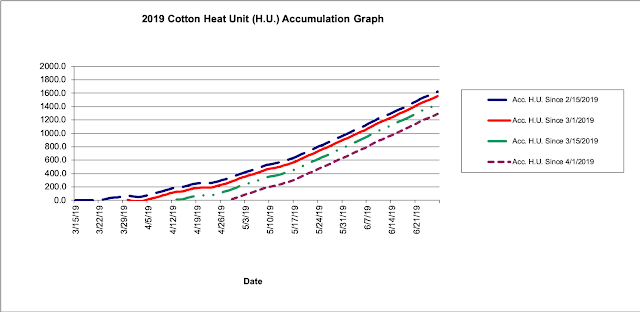Most of the cotton in the upper gulf coast is blooming now, so we've shifted most of our concern to stink bugs and bollworms. One constant I have seen in every field I've been in is aphids. This week especially every field I looked at had at least a moderate number of aphids. Our threshold for aphids is 40 to 70 aphids per leaf in cotton before we have open bolls. I've not been in a field with aphid pressure that high yet. If you know you've got them, I would try to avoid using straight pyrethroids to avoid flaring them. Otherwise, the aphids are feeding a healthy beneficial insect population that could help us out some.
I've seen green and brown stink bugs in all three counties this week. It is still buggy out there, and as our grain finishes out, more of them will move into cotton. To scout for stink bugs pull 10 to 20 bolls about an inch in diameter from four places in the field. Check the inside of the bolls for warts, lesions, and stained lint. Texas economic threshold for stink bugs is 20% or more of the bolls with internal damage and stink bugs present. Some of the brown stink bug populations in our area have also been shown to have some resistance to pyrethroids.
 |
| Green Stink Bug adult Kate Harrell |
 |
| Carpal Wall Warts from Stink Bug feeding damage Kate Harrell |
Below I have included information for stink bug thresholds from a South Carolina guide with good images of what damage looks like in bolls. Our cotton does not bloom as long as theirs, so the week of bloom threshold information will not line up exactly the same for our fields.
Bollworms, Helicoverpa zea, are caterpillars that feed on multiple crops and vegetables. In cotton they feed on squares and bolls, causing fruit loss. These past few years we have had high numbers of this insect in our Bt cotton as well. So far this year I have not seen bollworms larger than two to three days old. There is egg laying going on, but I have not seen larger caterpillars in cotton yet. I did get a report this week of a few tobacco budworm moths seen flying in the Blue Creek area. The caterpillar and eggs look like that of the bollworm, and our scouting recommendations are the same, but the budworm rarely reaches threshold in our area.
 |
| H. zea caterpillar in cotton square Kate Harrell |
 |
| Cotton Insect Guide |
The current A&M recommendation is to use pyrethroids with caution. In areas needing residual control Prevathon at 18-20 fl oz or Besiege at 9-10 fl oz works well. If you don't need residual control you can get by with Prevathon at 14 fl oz or Besiege at 7-8 fl oz.
 |
| Cotton Insect Guide |
 |
| El Toro Heat Units |
 |
| Bay City Heat Units |
 |
| Wharton Heat Units |
I hope everyone stays cool and has a good weekend. If you're not sure what kind of insect or issue you have, feel free to drop by the Wharton county office or give us a call.
Sincerely,
Kate Harrell
Looking for more information? Check out the Cotton Insect Guide
Need help with weed control? Check out the Weed Management Guide



No comments:
Post a Comment